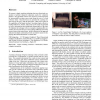Free Online Productivity Tools
i2Speak
i2Symbol
i2OCR
iTex2Img
iWeb2Print
iWeb2Shot
i2Type
iPdf2Split
iPdf2Merge
i2Bopomofo
i2Arabic
i2Style
i2Image
i2PDF
iLatex2Rtf
Sci2ools
VISUALIZATION
2003
IEEE
2003
IEEE
A Constraint-Based Technique for Haptic Volume Exploration
We present a haptic rendering technique that uses directional constraints to facilitate enhanced exploration modes for volumetric datasets. The algorithm restricts user motion in certain directions by incrementally moving a proxy point along the axes of a local reference frame. Reaction forces are generated by a spring coupler between the proxy and the data probe, which can be tuned to the capabilities of the haptic interface. Secondary haptic effects including field forces, friction, and texture can be easily incorporated to convey information about additional characteristics of the data. We illustrate the technique with two examples: displaying fiber orientation in heart muscle layers and exploring diffusion tensor fiber tracts in brain white matter tissue. Initial evaluation of the approach indicates that haptic constraints provide an intuitive means for displaying directional information in volume data. CR Categories: I.3.7 [Computer Graphics]: Three-Dimensional Graphics and Re...
Haptic Constraints | Haptic Rendering Technique | Secondary Haptic Effects | Visualization | VISUALIZATION 2003 |
| Added | 05 Jul 2010 |
| Updated | 05 Jul 2010 |
| Type | Conference |
| Year | 2003 |
| Where | VISUALIZATION |
| Authors | Milan Ikits, J. Dean Brederson, Charles D. Hansen, Christopher R. Johnson |
Comments (0)

